Stephen Covey's seven principles
Contents |
Abstract
This article connects the relations between Stephen Covey’s seven principles[1] and doing projects[2]. The principles are more often referred to as the seven habits of highly effective people , which describe the thoughts and steps you need to apply if you want to be an effective individual. While working in projects, it’s highly important to be effective thus do the right tasks, in the right order and with the correct timing. Being able to do that requires not only effectiveness in yourself, but also with the people you are collaborating with. Interesting parts of Covey’s thinking is how you must be able to manage yourself to manage other people, thus working in projects. The article follows the natural sequence of the seven principles: being proactive, beginning with the end in mind, putting first things first, thinking win-win, seeking first to understand then to be understood, synergizing and finally sharpening the saw. Each principle will be explained, connected to best practice in project management and discussing the possible pros and cons before moving on to the next principle, and finally connecting it all together.
Stephen Covey's seven principles
You might have heard the story about the farmer with the goose (the asset) producing one golden egg (the output) a day, who eventually cuts up the goose to get all the eggs inside. He does so in eager to get the golden eggs faster, thus only valuing the output and not the asset. The result is him getting no golden eggs. On the other hand, if you only focus on your assets you won’t get to profit in any way in life, and you will never be effective. We will go through different aspects of mindsets, behaviors and processes that can contribute to be a more effective individual[1].
On our way through the topics, we will compare Conveys principles with the skills needed when doing projects and processes you need to perform to do them effectively. We might discover that if you adapt some of Coveys principles into your life, you might be well suited to work with projects.
1. Proactive
Being proactive is very much about taking control of your life. Many people blame others for their lack of success. It’s very important to be conscious about the way we behave to develop a character that focuses on the meaningful things in life. There will always be different stimuli, but it’s how we react on those things that builds character, which later will make people follow your lead.
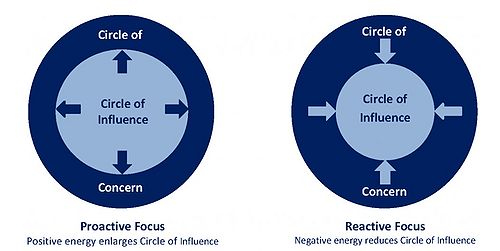
Circle of concern vs Circle of influence
When talking about circle of concern and circle of influence, the important thing is to focus on the circle of influence and to act on those things instead of being acted upon. Circle of influence refers to those things that you can change, and the circle of concern deals with things you can’t. You can’t change whether it’s going to rain or be a sunny day (concern). On the other hand, being proactive and acting (e.g. by pushing through that run in the park that you planned to no matter the weather) is within your control (influence). The secret here is that the times when the weather is bad and you still push through, the satisfaction will be even greater than otherwise, indirectly fueling the expansion of the circle of influence as shown in figure 1. Reactive people use their energy on matters in the circle of concern; things they can’t do anything about. They make excuses why they can’t do this and that, which unconsciously leads to the feeling of less control of life. This means that the circle of influence will shrink, also shown in figure 1.
There will be areas that are within our control (direct control), which directly correlates with the circle of influence . But also, things that are in our indirect control, depending on for example our work associates, where the habits can help to some extent. However, it’s important to learn new ways to deal with other people building up multiple layers of reasoning and argumentation to improve interaction. Most people fail to do this and tend to quickly go from reasoning to heated argument, with nothing in-between. Lastly there are things that we have no control of, equaling the circle of concern, and therefore shouldn’t use time on, apart from of course recognizing their existence.
“Enterprise environmental factors (EEFs) refer to conditions, not under the control of the project team, that influence, fluence, constrain, or direct the project. These conditions can be internal and/or external to the organization. EEFs are considered as inputs to many project management processes, specifically for most planning processes. These factors may enhance or constrain project management options. In addition, these factors may have a positive or negative influence on the outcome”[2].
Covey has a point that he wants to channel energy primarily towards the circle of influence. By doing so, the first step is being able to identify which elements have their origin where. According to doing projects the PMBOK guidance encourages to use significantly more resources working on factors that you might not have influence on. However, since the elements still can have a large impact on the project they are not to be underestimated. No matter whether you use time on the factors or not, acquiring the skills to categorize between the two areas is critical.
2. Begin with the end in mind
If you were to imagine yourself being at your own funeral, where people would do speeches about you, what would you like them to say about you? What kind of person, values or behavior would you like to be mentioned? If you can dig deep into yourself and answer those kinds of questions, then you know exactly what everything you do in life should be leading to. Any gap between what you are currently doing and these things would be shouting for changes. By thinking of your “end” in everything you do, it should be ensuring every step you take is in the forward direction as to what is valued for you specific[1].
“Projects are initiated to realize business opportunities that are aligned with an organization’s strategic goals”[2].
Mission statement
It is very important to write a mission statement with bullet points covering different topics such as[1]:
- What kind of person do you want to be?
- How will you live your life?
- What do you want to accomplish in your life?
These things should cover areas such as social-, family and professional life. The list as it is, does very little for you, but creating and frequently reviewing it is the true power of this concept. This allows you to remind yourself of what’s important to you and work forward those things. By changing your statements as you develop and grow as a person, your values may change as well. Organizational mission statement should be involving everyone from the top level to the bottom to ensure that everyone knows it and they buy into it.
The mission statement is directly comparable with the company’s strategy, and if it’s not clear what that is, then projects carried out by the company will not be streamlined for obtaining business benefits. It also makes sense when working in projects, because a lot of people are involved and different perceptions exist of what the goals to be accomplished are. By discussing and writing down, for review later when we acquire more knowledge of the area or supporting technology, new opportunities arise or scope changes.
Effectiveness vs Efficiency
“You can be climbing the latter of success, but the latter is leaning against the wrong wall.”[2]
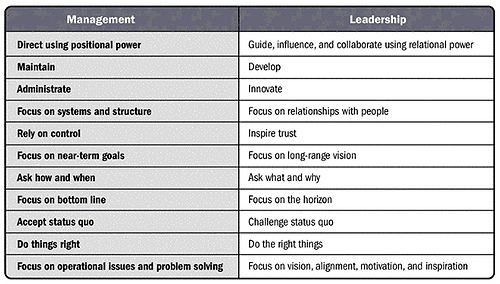
Effectiveness is about doing the right things. Efficiency is about how well you do these things. You can compare these concepts to the difference between leadership and management. Leadership is effectiveness and management is efficiency. Accordantly to Covey’s theory, leadership should come first and management second, though a certain balance between them is needed to get anything done. Doing well at leadership, knowing exactly the right things to do, but being entirely in lack of management, the final output will be zero.
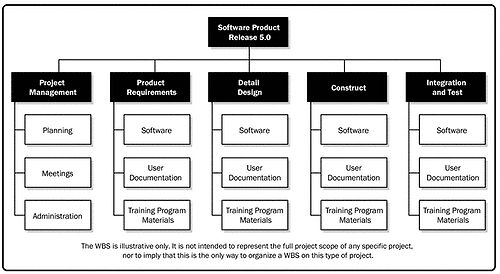
As shown in table 1, the PMBOK describes the differences between leadership and management containing the same elements as Steven Covey. However, the guidance does not directly indicate a preferred sequence as Covey does, at least it isn’t underlined as clearly.
By the right level of effectiveness, and by the belief that "all things are created twice" ; that you measure, draw or imagine all work in the mind initially, before doing the physical work of the objective, it should be possible to create daily activities that support and benefit the mission statement[1].
“The WBS is a hierarchical decomposition of the total scope of work to be carried out by the project team to accomplish the project objectives and create the required deliverables. The WBS organizes and defines the total scope of the project fines the total scope of the project and represents the work specified in the current approved project scope statement”[2].
By achieving the ability to visualize everything you want to do, before you do it, you are essentially doing a work break down structure as in the example in figure 2. This is as true for breaking down your personal activities as it is for breaking down a project. The difference may be the size of the main task, which is probably bigger for many projects than for personal tasks. By mastering the skill in personal life, you gain the ability to do it for projects as well.
3. Put first things first
This is about personal management; independent will. The first two habits make you mentally aware of yourself being in charge, and through leadership thinking able to make the right decisions. Putting first things first is about personal management and effort; doing what non-successful individuals won't do, because they "don’t feel like it today" (feelings driven). Being an effective individual, you will do those things because you are value driven and your inner strength will push you through those days where most people quit[1].
Time Management
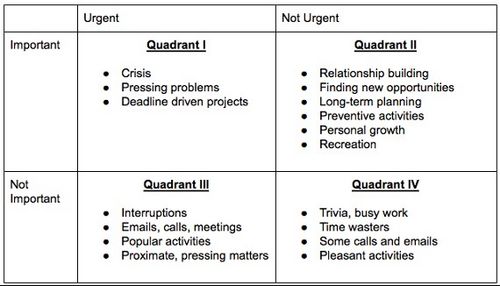
For being able to get things done, time management is very critical. There are different levels on which to do planning of time and tasks. In the following list, level one is the most basic, gradually advancing to level four, which in this example is the highest reachable state:
1. Notes and checklists
Here things to remember are noted, but there is no actually timeframe or sequence of the tasks.
2. Calendars and appointment books.
At this level there is sequence and duration expectation, but no actual prioritizing has taken place.
3. Daily scheduling
Prioritize tasks in their relation to the importance to you. Setting daily - short term and long-term goals, and then stick to that plan. However, most people quit on it in the long run, it’s very hard to continuously carry out such harsh planning every day, which tends to lead to abolishment.
4. Weekly scheduling
Maintaining balance between the asset and the output, which means spending time on those tasks that will benefit in the long run as well to some extent the urgent tasks as well. We all know the feeling of urgent tasks taking over your day, and you don’t get anything else you planned done. The way to go around this is to start planning on a weekly basis instead of daily. Planning to do all tasks that you wish in one day will completely exhaust you, but squeezing in the meaningful tasks on different days to cover all wishful aspects over a week is much more sustainable.
Importance vs urgency matrix
If things are important but not urgent most people tend to react on the less important but urgent inputs. That is why the second habit is very important, since it enables us to acknowledge the importance. To classify different tasks, observe figure 3. Effective individuals tend not to use time in Q3 and Q4, simply because the things here are not important. Q2 is where you want to be because, in the long run, these tasks are the ones that really matters. Your can say that Q2 is opportunities and Q1 is problems. You must learn to say no to generate the time you need to put into Q2[1].
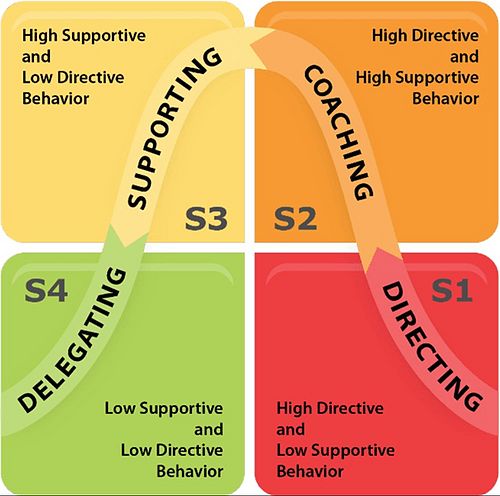
"Project Schedule Management includes the processes required to manage the timely completion of the project"[2].
In being able to do useful scheduling, three main inputs are required:
- Defined activities
- Sequenced activities
- Estimated activity durations
From the previous habit the skill to define the activities is already in place through the work of WBS. By working up from Covey’s time management step 1 to step 4, it’s exactly the competencies needed to do scheduling in projects. Covey’s angle though is primarily on personal scheduling thus not very focused around resources. From a project perspective the possibility of allocating more resources to specific tasks and moving those resources from one area to another as the project involves is present.
Delegation
Effective management is about delegating. You will grow as an organization and you will personally get more time. There are different types of delegation of work :
- Gofer delegations
This is basically being a joystick controlling whoever you are delegating to. Orders are given very specifically, frequently and without any space for adjustments. Practically it means that there is no difference between delegating the work and doing it yourself. You can argue that you get the job done the way you like, but you might miss out on new creativity that could result in better solutions, and you surely don’t save any time by giving directions all the time.
- Stewardship delegation
Here you provide the benefit you wish out of it, instead of the methods to achieve the goal. It’s possible that while specifying the requirements for the result, you give limitations on specific methods you don’t want, but otherwise there is room for personal touch in the tasks.
There is a somewhat negative tone to what Covey describes as gofer delegation, but if you compare it with situational leadership theory[6], depending of the knowledge or skill level of an individual for a specific task, directing (gofer delegation) might be the only right thing to do initially. As that person then acquires more expertise doing that task, eventually it ends up more appropriate to do delegation(stewardship)as illustrated in figure 4. The cycle then starts all over when new challenges arise. The take away is that being able to know and acknowledge differences helps you provide the right delegation method.
4. Think win-win
Having a vision can be very powerful, and you may find yourself entering into very strong arguments when you represent certain ideas. But it’s very important to keep in mind the long-term effect of how you deal with decision making.
“You can’t change the fruit if you don’t change the root”[1]
There is different mindset to people when it comes to taking decisions.
- Win-Win
Not your way or my way - it's a better way.
- Win-Lose
- win - you lose - Use of position, power etc.
- Lose - Win
A pleaser - Being a nice guy.
- Lose - Lose
Can arise when two win-lose persons meet each other. They are heavily caught up by the desire for the other person not to win, even if it means not winning themselves.
- Win
Just want to win, don’t want anyone to lose, but it should be up to themselves how to go about it.
- Win-Win or no deal
Having the option of "no deal" enables you to really go far to understand the needs of both parties and not trying to push through your own agenda.
Ideally, we want to be in a position where Win – Win happens. This builds much more sustainable relationships and will also be an investment for future situations. It’s easier to support someone who acts with integrity, maturity and exhibits confidence. Building these relationships with people by creating trust is the key to get to win – win situations[1].
“Research shows that the qualities and skills of a leader include but are not limited to: Being a visionary (e.g., help to describe the products, goals, and objectives of the project;and able to dream and translate those dreams for others); Being optimistic and positive; Being collaborative; Managing relationships and conflict by:
- Building trust;
- Satisfying concerns;
- Seeking consensus;
- Balancing competing and opposing goals;
- Applying persuasion, negotiation, compromise, and conflict resolution skills
- Developing and nurturing personal and professional networks;
- Taking a long-term view that relationships are just as important as the project
- Continuously developing and applying political acumen.”[2]
5. Seek first to understand, then to be understood
Trying to provide a solution before you even understand the problem, is what frequently happens when different people share issues or experiences. Most people don’t make the effort required to truly understand the person the are talking with. Listening while you preparing an answer is not where you want to be if you trying to understand. You will need to dig deep inside and get rid of underlying agendas and just listen to the individual’s real problem or perception of a situation, first then when you truly understand, when sincerely trust and openness appear, can you expect the other person to understand you as well. That’s a worthy starting point for reaching win – win situations. It’s not enough performing well trained listening techniques, because people feel the difference between authentic empathy and a play, and then they won't fully open themselves up, and no matter how good you advise are, there is simply shut down.
The most important skill in life is communication. There are 4 different types;
(10 % is words we say)
(30 % is by our sound)
(60 % is body language)
1. Reading
2. Writing
3. Speaking
4. Listening
As people most of us lacking the training of truly listening. Reading, writing and speaking are all topics taught in school, but that’s not the case at all for listening.
Being able to truly understand is very useful for example when you decide how to run your business. If you do not fully understand your costumer, how can you design the product right?
Seek to understand is very central to circle of influence and as you do understand the circle will expand, and that way you become more effective simply by doing more emphatic listening.
6. Synergize
– WILL BE UPDATED
7. Sharping the saw
– WILL BE UPDATED
Conclusion
– WILL BE UPDATED
Annotated bibliography
– WILL BE UPDATED
References
- ↑ 1.0 1.1 1.2 1.3 1.4 1.5 1.6 1.7 1.8 Covey, Stephen R. THE SEVEN HABITS OF HIGHLY EFFECTIVE PEOPLE. New York : Rosetta Books LLC, [2012] ©2012.
- ↑ 2.0 2.1 2.2 2.3 2.4 2.5 2.6 2.7 2.8 Project Management: A guide to the Project Management Body of Knowledge (PMBOK guide) 6th Edition (2017).
- ↑ https://dplearningzone.the-dp.co.uk/2015/06/24/coveys-circles-of-influence/
- ↑ https://facilethings.com/blog/en/time-management-matrix
- ↑ https://www.catalysts.cc/the-catalysts-way/9-4-situational-leadership/
- ↑ Hvordan organisationer virker